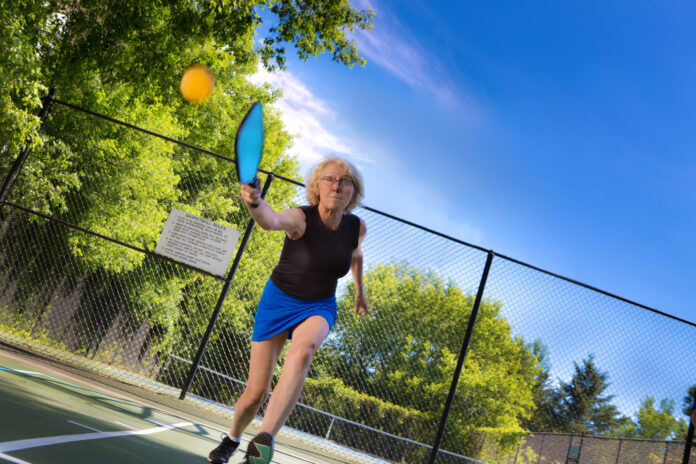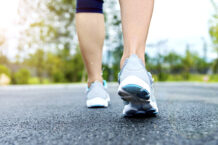You’ve probably at least heard of the sport called “pickleball,” an inviting amalgam of tennis, badminton, and ping-pong. With its super easy-to-learn rules, it’s said to be the fastest-growing sport in the U.S. There are now more than 38,000 pickleball courts around the country, with more being built at a record rate to try to keep up with demand. The number of players grew nearly 40 percent between 2019 and 2021 to almost 5 million, according to the Sports and Fitness Industry Association.
Many of those enjoying pickleball—and improving their cardiovascular health and overall fitness while doing so—are middle aged and beyond. People 65 and older make up a third of pickleball’s core players, that is, those who go at it at least once every month or two. There has even been increased demand for pickleball courts at senior living facilities.
Non-athletes welcome
It’s easy to understand the appeal. A pickleball court is only about half the length of a tennis court, so you don’t have to cover as much distance chasing after the ball. In fact, between three and four pickleball courts would fit on one tennis court. And the paddle has a much shorter handle and is lighter than a tennis racket, which makes it relatively easy to hit the sport’s lightweight plastic ball (with holes in it) back and forth across a net.
As in tennis, you can play singles or doubles, so it presents a great opportunity for socializing one-on-one or with other pairs. That’s especially true because the players are relatively close to each other on the small court. Moreover, you serve underhand—thwacking with as much force as possible is not a serve’s aim. You can’t thwack that hard during a volley, either. The ball’s material doesn’t allow for it. The game is “accessible” enough that you can play it from a wheelchair, whether on an indoor court or outside.
The game even has endearing terms that make it welcoming to newcomers. The “kitchen” is a spot in front of the net you’re not allowed to step into to volley. A “dink” is a type of soft shot. The word “pickleball” itself is adorable. It purportedly comes from the wife of one of the inventors—three fathers on Bainbridge Island in Washington State who, in the summer of 1965, invented the game in response to their kids whining about being bored. (Accounts of the term’s origin vary. Some say it was the name of one of the family’s dogs. Others maintain that it comes from the pickle boat in crew, where oarsmen are chosen from the leftovers of other boats.)
Safety first
For all the cozy terms and the small court and easy-to-handle equipment, those wanting to get in on the pickleball action should be physically ready in order to avoid injury. This is especially true for older people, who may have been sedentary for a while or whose exercise has for years consisted of going for walks and not much else. How fit you need to be depends on how vigorously you play, of course. Not everybody is going to chase after the ball. They may just want to be a little bit more active than usual while socializing.
Still, “pickleball is not shuffleboard,” says Cindy Chang, M.D., a member of the Wellness Letter editorial board who has served as the president of the American Medical Society for Sports Medicine and the head team physician for the University of California, Berkeley. You’re going to raise your heart rate to some degree while playing and probably work up at least something of a sweat. Therefore, “you have to have a level of preparedness,” Dr. Chang says.
Indeed, a study in the Journal of Emergency Medicine on pickleball accidents estimates that between 2001 and 2017, some 10,000 injuries brought people to hospital emergency rooms. Those 50 or older accounted for more than 90 percent of all patients, with men and women divided pretty evenly. The most common injuries were strains and sprains, followed by bone fractures, and the lower legs were the most common site for mishaps. This doesn’t even begin to get at the number of pickleball injuries people sustained that did not bring them to emergency rooms—a figure assumed to be much higher. And with pickleball growing by leaps and bounds in popularity, injuries have no doubt gone up since the study was conducted.
There is a dynamic nature to the sport, Dr. Chang explains—starting, stopping, cutting, side-to-side movements. Combine that with people who may not have been active for years, and the injuries start to add up.
With that in mind, anyone who wants to start playing pickleball and has had knee replacement surgery or, say, a recent ankle sprain or perhaps a rotator cuff problem at some point should start by seeing a physician who specializes in sports medicine or an orthopedic surgeon—or perhaps an athletic trainer or physical therapist. Ideally, it’s someone they’ve worked with in the past whom they could ask for an evaluation to make sure their previously injured body part has regained its flexibility and strength. Seeing your physician first is also not a bad idea for anyone who has been fairly sedentary for years to ensure that they have no cardiac or other medical risk factors before starting this new exercise program.
For those who have been relatively inactive, Dr. Chang recommends an average of three to four weeks of aerobic and strengthening exercises, at least three times a week, prior to picking up a pickleball paddle (say that five times fast!). You want to start doing some exercises that require dynamic movements similar to the ones done during pickleball before getting on the court, especially if in the past you have had low back issues, hip or hamstring injuries, or injuries to the lower legs. (See the box below for how to get started.)
Psyched—and realistic
As you’re prepping to hit the court, set expectations. Think through whether you want to play pickleball to meet more friends, to become more active again, or to compete for trophies. All are laudable goals, and they may morph as you become more comfortable with the sport. Dr. Chang suggests watching some videos of people playing pickleball as well as going to see people playing in your community so you get a feel for its physical demands and whether you would enjoy it.
Also, as you prepare physically, you want to prepare psychologically. As Dr. Chang says, “You have to know your limitations. All of us feel sometimes like we’re 20 years younger than we are. That same competitive spirit is still there in your mind, but your body may not be quite as responsive as your spirit.”
Here are some good exercises for getting ready to play pickleball. You can find videos of many of them in the American Council on Exercise’s Exercise Database & Library. A general rule of thumb is to do 10 repetitions of each exercise (one set), once a day to start. If you find they are too easy and you don’t feel a “burn” in your muscles, then increase to two and then three sets of each exercise.
The goal of these exercises is to prevent muscle and tendon strains and even complete tears such as Achilles tendon ruptures. But if you have any musculoskeletal issues, it’s best to check with your doctor or a physical therapist before starting to make sure the exercises are not contraindicated for you and to make sure you are doing them correctly.
Heel raises. Start with bilateral heel raises, then progress to unilateral—one heel at a time.
Squats. You can start by holding onto the back of a chair to help you squat and progress from there.
Lunges. This involves bending the front knee in front of you with the back knee bent behind while keeping the torso erect, then returning to the starting position. Once you are comfortable with this exercise, try some mini jump lunges.
Jumping/skipping rope. Do this especially if you could skip rope when you were younger. It will help build agility and footwork and is a good aerobic workout as well.
Carioka. Not singing. It’s running sideways with your feet crossing both in front of you and behind you. This, too, develops agility and footwork skills.
Modified burpees. Get into a squatting position and then jump comfortably upwards, reaching your arms in the air. Make sure you land with your knees slightly bent to absorb the landing shock.
The Frankenstein walk. Walk with your hands in front of you, like Frankenstein, and kick up your leg comfortably toward your palms with your knee as straight as possible and then lower slowly.
Shoulder exercises. Stretching and strengthening exercises will help you avoid injuries to your shoulder. Lifting light dumbbells or even a can of soup can strengthen your rotator cuff muscles.
For more information on how the game is played, what a court looks like, pickleball gear, and other information, check out:





